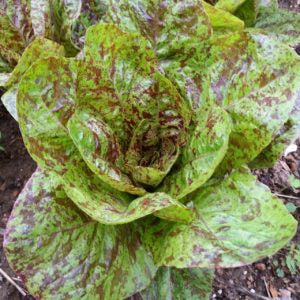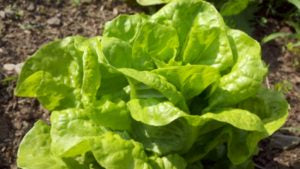 Almost synonymous with salad, lettuce is one of the easier-to-grow garden vegetables, promising the full, green bounty of warmer months to come. It not only adds a colorful, crisp crunch to your spring and summer meals, it's nutritious as well, containing Vitamin A, Calcium, and Potassium among others. But it can be hard to remember your Bibbs from your Butterheads, your Cos from your Crispheads. And what's the difference between all of these varieties anyway? Read on for a summary of the different types of lettuces and some specific differences to be aware of when choosing the perfect variety for you.
Almost synonymous with salad, lettuce is one of the easier-to-grow garden vegetables, promising the full, green bounty of warmer months to come. It not only adds a colorful, crisp crunch to your spring and summer meals, it's nutritious as well, containing Vitamin A, Calcium, and Potassium among others. But it can be hard to remember your Bibbs from your Butterheads, your Cos from your Crispheads. And what's the difference between all of these varieties anyway? Read on for a summary of the different types of lettuces and some specific differences to be aware of when choosing the perfect variety for you.
 1. Looseleaf Lettuce - so named because these lettuces do not form a compact head. They are the easiest lettuces to grow, and normally the most tolerant of heat and cold. Looseleafs are also the fastest to mature and the most nutritious (along with Romaine below). Examples include: Amish Deer Tongue, Black Seeded Simpson, Italienischer, Prizehead (despite its name!), Really Red Deer Tongue, Red Salad Bowl, and Royal Oakleaf. Our varieties mature between 45 and 55 days.
1. Looseleaf Lettuce - so named because these lettuces do not form a compact head. They are the easiest lettuces to grow, and normally the most tolerant of heat and cold. Looseleafs are also the fastest to mature and the most nutritious (along with Romaine below). Examples include: Amish Deer Tongue, Black Seeded Simpson, Italienischer, Prizehead (despite its name!), Really Red Deer Tongue, Red Salad Bowl, and Royal Oakleaf. Our varieties mature between 45 and 55 days.
 2. Butterhead (Boston) / Bibbs Lettuce has a soft, loosely packed head and delicious, buttery flavor. Bibbs tends to be slightly darker and smaller than other Butterheads. Butterheads are fairly easy to grow and tolerate moderate heat. Examples include: Blushed Butter Oak, Buttercrunch Bibb, Flashy Butter Oak, North Pole, Philadelphia Dutch, Pirat, and Tom Thumb. Our varieties mature between 50 and 65 days.
2. Butterhead (Boston) / Bibbs Lettuce has a soft, loosely packed head and delicious, buttery flavor. Bibbs tends to be slightly darker and smaller than other Butterheads. Butterheads are fairly easy to grow and tolerate moderate heat. Examples include: Blushed Butter Oak, Buttercrunch Bibb, Flashy Butter Oak, North Pole, Philadelphia Dutch, Pirat, and Tom Thumb. Our varieties mature between 50 and 65 days.
 3. Romaine (Cos) Lettuce has tall heads of green leaves with crisp ribs down the leaf centers. Romaine is considered by some to be the best flavored of the lettuces. It's also fairly heat tolerant and one of the most nutritious. Examples include: Paris Island Cos and Spotted Trout. Our varieties mature between 55 and 65 days.
3. Romaine (Cos) Lettuce has tall heads of green leaves with crisp ribs down the leaf centers. Romaine is considered by some to be the best flavored of the lettuces. It's also fairly heat tolerant and one of the most nutritious. Examples include: Paris Island Cos and Spotted Trout. Our varieties mature between 55 and 65 days.
4. Crisphead Lettuce has a dense head of crisp leaves. While Crispheads are technically the least nutritious of the lettuces, they are loved for their crisp, crunchy texture. They are also a favorite of supermarkets - valued for their ability to survive arduous handling and shipping processes. Examples include: Iceberg, and Joker. Our variety matures in 55 days.
 5. Summercrisp Lettuce is somewhere between a looseleaf and crisphead. A large lettuce variety, it is resistant to bolting and relatively heat tolerant. An example is Magenta which matures in 50 days.
5. Summercrisp Lettuce is somewhere between a looseleaf and crisphead. A large lettuce variety, it is resistant to bolting and relatively heat tolerant. An example is Magenta which matures in 50 days.
While lettuce is pretty easy to grow, one of the challenges is getting it to grow when you want it since lettuce doesn’t love hot weather and it doesn’t stay in prime condition for very long. So here are several other factors to consider when choosing your perfect lettuce:
- Bolt resistant / heat resistant - bolting is when the plant becomes bitter and begins to go to seed. Lettuce tends to bolt quite quickly, mainly triggered by the heat. If you'd like to keep harvesting all summer long, look for varieties that do well in the heat such as: Joker, Magenta and Paris Island Cos, Royal Oakleaf, and Spotted Trout.
-
 Cold hardy - lettuce is less cold hardy than other greens, such as Kale or Spinach. Some varieties do better in cold weather than others and this will extend your growing season. This includes varieties such as Joker, North Pole, and Royal Oakleaf.
Cold hardy - lettuce is less cold hardy than other greens, such as Kale or Spinach. Some varieties do better in cold weather than others and this will extend your growing season. This includes varieties such as Joker, North Pole, and Royal Oakleaf. - Cut and come again - this refers to the harvesting of the relatively older, outer leaves of the lettuce (while they're still pretty young) and allowing the center of the plant to continue growing new leaves. This makes for easy harvesting for salads since you're just harvesting the leaves not the heads. And it extends the lifetime of your lettuces since you will generally be able to harvest the lettuce leaves up to 3 times before they start to turn bitter. The looseleaf varieties are all great cut and come again varieties. Some of our favorites include: Black Seeded Simpson, Metta Lettuce Mix, Really Red Deer Tongue, and Red Salad Bowl.
-
 Container - most lettuce varieties will do well in containers. There can even be an advantage to being able to move them your lettuce plants out of the sun when it gets too hot. There are also some dwarf varieties such as Tom Thumb, which top out around the size of a large apple, and Little Gem Lettuce Mix which max out around 8".
Container - most lettuce varieties will do well in containers. There can even be an advantage to being able to move them your lettuce plants out of the sun when it gets too hot. There are also some dwarf varieties such as Tom Thumb, which top out around the size of a large apple, and Little Gem Lettuce Mix which max out around 8". - Flavor and color - there's a surprising amount of variety in the different lettuce varieties. Colors range from the deep wine color of Merlot, to the strikingly specked Spotted Trout, to the leaf-tipped Blushed Butter Oak, to the vivid greens of Italienischer. The strongest flavors are normally associated with the Romaine varieties but the sweet, buttery flavors of Butterheads are delicious, as is the delicate flavor of many looseleafs. We must be biased, but we think they all taste good!
What did we miss? Let us know!






